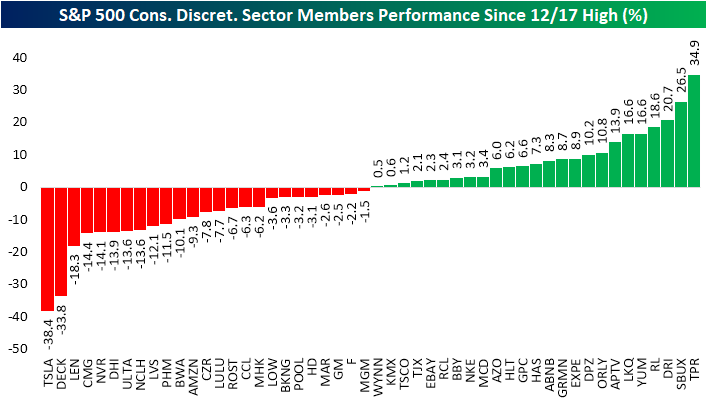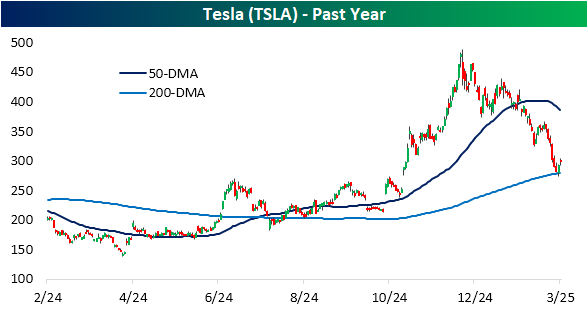February 2025 Headlines
Chart of the Day: S&P 500 Bad Starts
Bespoke’s Morning Lineup – 3/4/25 – Fear & Uncertainty
See what’s driving market performance around the world in today’s Morning Lineup. Bespoke’s Morning Lineup is the best way to start your trading day. Read it now by starting a two-week trial to Bespoke Premium. CLICK HERE to learn more and start your trial.
“The only thing we have to fear is fear itself.” – Franklin D. Roosevelt
Below is a snippet of commentary from today’s Morning Lineup. Start a two-week trial to Bespoke Premium to view the full report.
Target CEO Brian Cornell appeared on CNBC earlier, and while we didn’t count, throughout an interview lasting just a few minutes, it seemed like the term “certainty” was mentioned dozens of times, as in there is none. The current market sell-off that’s still less than two weeks old has been driven to this point almost entirely by fears and uncertainty as opposed to actual events. Fears and uncertainty over the economy, fears and uncertainty over interest rate policy, fears and uncertainty over US trade policy, fears and uncertainty over tax policy, fears and uncertainty regarding geopolitical stability. We get it. There’s always uncertainty, but this has been a different level. Like a box of chocolates, you never know what you’re going to get, except that lately they’re all flavors nobody likes (think Orange Cream, Maple Nut Butter, Cherry Cordial, etc).
This morning, you could say we’re getting some certainty as tariffs with China, Canada, and Mexico take effect. These moves are all expected to have an inflationary impact (Cornell noted that produce prices will start rising this week), but that’s not being reflected in crude oil prices and Treasury yields. Equity futures were looking eerily quiet earlier this morning. However, as we approach the opening bell, the tone has steadily weakened as international markets have also moved sharply lower. There’s not much to speak of in terms of economic data today, so unless there are any impromptu comments from the President during the day, the next potential catalyst will be tonight’s address to Congress tonight.
Heading into last week’s earnings report from Nvidia (NVDA), most investors assumed the company would report better than expected results. Based on the company’s past reporting patterns and the comments from the major hyper-scalers when they reported earlier in earnings season, it was also almost a foregone conclusion that the company would raise guidance, especially because they only provide short-term guidance a quarter out. Whatever impact, if any, DeepSeek would ultimately have, it wasn’t going to change short-term spending plans for the coming three months. Given that, in last Wednesday’s email of the Morning Lineup, we mentioned that “How the market reacts to that report could give us a good idea of the market tone as we head into Spring.”
NVDA’s performance since then hasn’t been a good omen, as the stock is down over 13% since its report. As shown in the chart below, NVDA’s price chart, which was already trending lower, now looks like it’s breaking down, and yesterday, the stock closed at its lowest level in close to six months (9/18/24).
The chart below shows every day since the launch of ChatGPT at the end of November 2022 and how many days had passed since NVDA last closed lower than that day’s close. Since the launch of ChatGPT, NVDA has never closed at a 52-week or even a six-month low, and yesterday was the first time it closed even at a 166-day closing low.
Since it comprises about 7% of the Nasdaq, NVDA’s plunge yesterday also took the Nasdaq marginally below its 200-DMA, which is a place it hasn’t been in more than a year – 333 trading days to be exact. The breakdown below its 200-DMA was only the 11th time the index ran more than a year without closing below that level. This just-ended streak ranked as the 7th longest streak of closes above the 200-DMA of all time.
Get Invested: Don’t Get Political
Our “Get Invested” series is a simple yet powerful resource designed to help anyone understand why investing in stocks for the long term is one of the best financial decisions they can make. The slide below from our Get Invested piece is titled “Don’t Get Political.”
Letting political beliefs get in the way of “buy and hold” has been extremely costly to investors. Going back 70 years, $1,000 invested in the US stock market only when a Republican is President would be worth $28,000 today. $1,000 invested only when a Democrat is President would be worth more than double that at $72,000. But that $1,000 would be worth almost $2 million today for those who put politics aside and stayed invested regardless of who’s in charge in Washington DC.
If you have any questions about our Get Invested resource, please email us or give us a call at 914-315-1248. You can view the full piece by becoming a Bespoke client.
Click here to learn more about Bespoke’s wealth management services.
The Closer – Tariffs Confirmed, Bad PMIs, Housing – 3/3/25
Log-in here if you’re a member with access to the Closer.
Looking for deeper insight into markets? In tonight’s Closer sent to Bespoke Institutional clients, we lead off with an update on the tariff front (page 1) followed by a check up on stock and bond correlation (page 2). Next, we review the latest PMI data in the forms of S&P Global (page 3) and the ISM figures (page 4). We also show what this implies for GDP tracking (page 5). Next, we dive into the latest housing data regarding mortgage debt (page 6) and inventories (pages 7 and 8).
See today’s full post-market Closer and everything else Bespoke publishes by starting a 14-day trial to Bespoke Institutional today!
Daily Sector Snapshot — 3/3/25
Bespoke Matrix of Economic Indicators
Our Matrix of Economic Indicators provides a concise summary analysis of the US economy’s momentum. We combine trends across the dozens and dozens of economic indicators in various categories like manufacturing, employment, housing, the consumer, and inflation to provide a directional overview of the economy.
To access our newest Matrix of Economic Indicators, start a two-week free trial to either Bespoke Premium or Bespoke Institutional now!
Bespoke Market Calendar — March 2025
Please click the image below to view our March 2025 market calendar. This calendar includes the S&P 500’s historical average percentage change and average intraday chart pattern for each trading day during the upcoming month. It also includes market holidays and options expiration dates plus the dates of key economic indicator releases. Click here to view Bespoke’s premium membership options.
Where’s the Weakness in Discretionary?
Entering the final month of the first quarter, most S&P 500 sectors are sitting on year-to-date gains, although there are two notable exceptions. The Tech sector is currently down 5.29%, which has dragged on broader market performance, given it’s by far the largest sector by market cap. Consumer Discretionary is down an even worse 5.65% year to date, and returns look even worse when compared to the December 17th high. Since then, the sector is down just under 12%. As shown below, using the sector ETF (XLY) as a proxy for the group, that latest correction leaves it in no-man’s-land between the 50 and 200-day moving averages with the recent low finding some support around the November post-election low.
Taking a look under the hood, breadth since that December high hasn’t been that bad. Of the 50 stocks in the sector, half are higher, and half are lower since the high. However, there is a far larger weight in the losers than the winners. Among the decliners are the sector’s largest names: Tesla (TSLA) and Amazon (AMZN). Given that the S&P 500 is weighted by market cap, those declines in the mega caps—namely the outsized 38.4% drop in TSLA shares—have acted as significant drags on broader index performance.
Zeroing in on Tesla (TSLA), the stock peaked a day after the Consumer Discretionary sector, closing at a 52-week high on December 18. Regardless, it’s been a brutal period of selling since then. The stock’s nearly 40% decline saw it crash through its 50-DMA, and in the past few days, it has found support at its longer term 200-DMA.
Again, the S&P 500 and its sectors use a market-cap-weighted methodology, meaning stocks with larger market caps (like Tesla) will have a greater impact on the index than smaller peers. That also makes equal-weight versions of the indices useful in canceling out some of that noise and providing a better look at breadth. As shown below, whereas the market-cap weighted sector ETF (XLY) is down 9.6% from a 52-week high, the equal weight version (RSPD) is down less than 3%. Furthermore, whereas XLY looks like a falling knife, RSPD has just been bouncing sideways along the 50-DMA. The latest lows for RSPD came right at the uptrend line off of last summer’s lows. So all together, while the weakness in the Consumer Discretionary sector may cause some alarms to go off as a sign of stress for the consumer, the current situation is more looking like a lesson in index weighting methodologies and mega-cap volatility.













